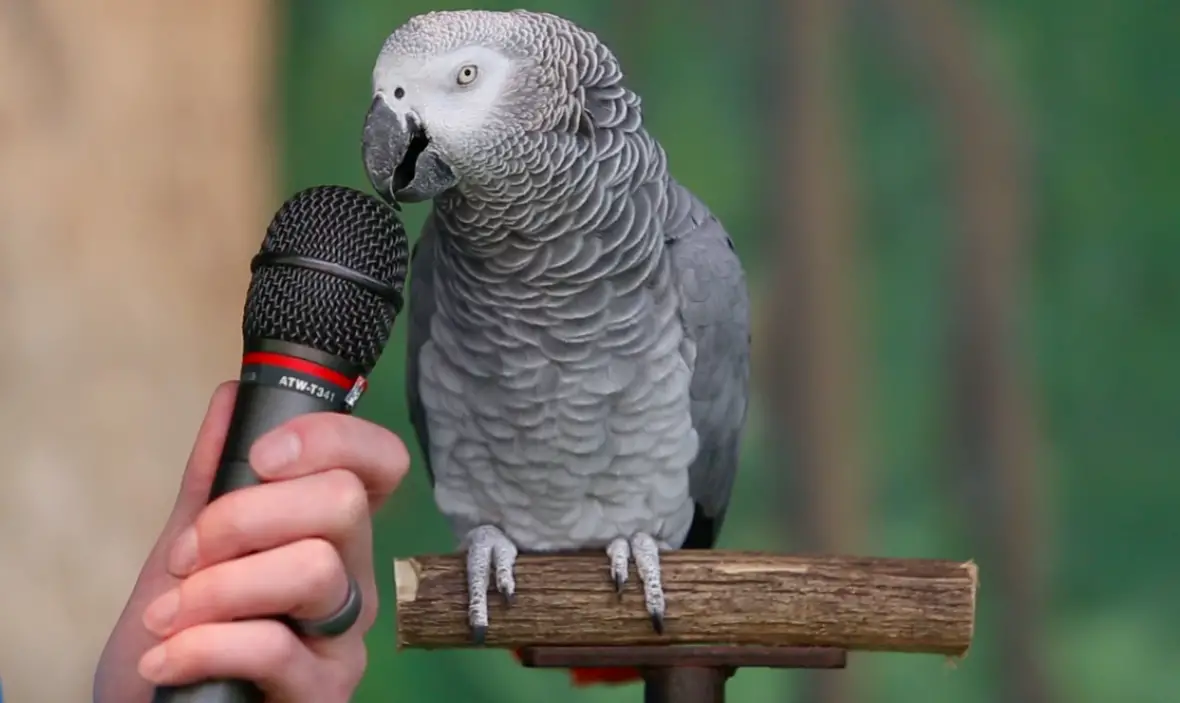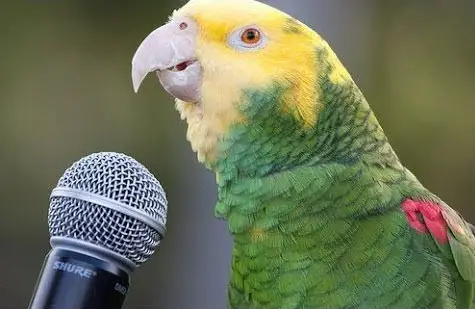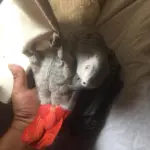
How do parrots talk, All parrots are not great speakers: some will just mimic some noises when others will be able to articulate whole sentences.
The African Grey Parrot (P. Erithacus) is undoubtedly the most talkative, but other Psittacidae Psittaciformes such as Amazons Parrots (Amazona sp.), Eclectus Parrot (Eclectus roratus), or Senegal parrot(Poicephalus senegalus) are also able to pronounce some words.
However, speech remains a very self-dependent exercise and if his parrot is a speaker, the owner can very easily reinforce this behavior and teach him words.
Parrots generally begin to vocalize at an early age by first emitting indistinct gurgles. Then, they will begin to imitate the sounds they hear on a daily basis: songs of wild birds nesting next to their aviary, telephone, doorbell, microphone ringing, etc.
The owner generally reinforces this behavior by interacting with his bird (laugh, look, attention paid, etc …) and sometimes even without realizing it (for example, a parrot placed in the lobby mimics the sound of sonette and the owner comes to him to open to potential visitors: the parrot receives attention, the behavior is reinforced).
How to Teach a Parrot to Speak?
HERE’S HOW TO TEACH YOUR PARROT TO TALK
The bird will then imitate more and more sounds, melodies, and even words beginning with those he will hear most often (his name, that of his owner, etc …).
Parrots seem to perceive sounds in the same way as humans (optimal auditory sensitivity between 2 and 5 kHz, like humans), and the sound formation in Psittacidae can be compared to that of humans. Indeed, in the bird is the syrinx (an organ located at the base of the trachea) that impels the air an initial frequency, thus emitting a sound (the equivalent of vocal cords in humans).
The amplitude variation of this frequency makes it possible to form different vowels. Like the man, the bird will then use his tongue (height of the tongue, front/back position, etc …) to form other sounds and stop the consonants.
Why does my Parrot stop speaking?

Despite their great learning abilities, parrots are not able to learn to speak a language: for them, a sentence is only an association of sounds that they know how to imitate and that they will emit in a context very special that they have learned to recognize (example seen in the consultation: a parrot who hears the rain outside and associates this sound with the phrase “Put on your boots” which he repeats to his owner as soon as he wants to go out).
The learning of words is, therefore, an exercise like any other that the owner can work with his bird, either by positive reinforcement (reward as soon as the bird says the desired word) or by the method of “model/rival” described by Irene
Pepperberg: the parrot is placed in front of his trainer who shows him objects to name and another human. If the bird is wrong in naming an object, the owner turns his attention away from him and has the object named to the other person present.
If he is right, he is rewarded by his owner and can give the appointed object to the other person who becomes his apprentice comrade. Thus, the second person is both a model for pronouncing words and a rival for the coach’s attention.
This double relationship can be very motivating for the bird but this method is not recommended for owners who lack experience in training because the risk of the frustration for the parrot is great and it may then refuse to work with its owner

Thus, the best method of learning to speak to a parrot is often to let the bird by “suggesting” sounds to imitate (music or words repeated regularly, etc …). In most cases, it is he who will surprise his owner by repeating sentences that he himself has decided to learn.
1. Know your bird
The first step in teaching your bird to vocalize is to bond with your feathered friend and build reasonable expectations. Indeed, not all species of parrots can speak. And even those who have the capacity sometimes choose not to use it.
To determine if your tropical bird is a good candidate for learning to speak, do some research on the web or with a geek. Some birds speak better than others. So you shouldn’t expect your pet to say more than he can.
2. Choose your words wisely
The best way to encourage your parrot to speak is to choose a few short words to start with. Examples of good starting words include “hello”, “goodbye” or even your bird’s name.
Simple words, when spoken with enthusiasm, seem to become more interesting for most parrots. Make sure that when you talk to your bird, you do so in a cheerful and positive tone.
Parrot dialogue
Watch your bird as you repeat the words you have chosen. If you are careful, you will probably see that some words will grab his attention more than others. Use the word your bird best responds to for your first “training word”.
3. Repeat the word or phrase as often as possible
Once you’ve locked a word that interests your feathered friend, repeat it as often as you can. Parrots learn to imitate through repetition. So repeating the word over and over is the only way to encourage your bird to say it back.
Talking parrot
Although it is always best for owners to teach their pets directly. Some of them choose to use additional learning tools such as tape recorders and CDs to teach their parrots to speak.
Using these tools can be effective and will certainly not hinder the training process. But owners should be aware that they are not a substitute for individual interaction and that they should only be used as additional training tools.
4. Be patient and don’t be discouraged
The quickest way to encourage a bird to speak is to establish a workout routine and work with it every day. However, even this method is not fully guaranteed to work. While some parrots get used to human speech quite easily, others take months or even years to say their first word.
Some will never speak. Even owners who work diligently with their pets sometimes end up with a bird that doesn’t say a word.
If you feel like your bird is taking too long to learn to speak. Try teaching something a little easier, like whistling. Many birds find it much easier to whistle than to imitate a speech.
This is why some may be more willing to try it. With love, patience, lots of practice, and training time, most parrots will learn to imitate something. Pay attention to the vocalizations your bird makes during the day. Like environmental sounds, you hear every day in your home, like phones, microwaves, and doorbells.
Even if your bird never says a word, you shouldn’t feel wrong. Speech learning, interaction and socialization help strengthen the bond between you and your pet. So, if your bird remains silent, you will still have established solid links with your companion.
For the little ones who would like to speak with a parrot, we offer interactive parrot plush toys. It is a very good alternative to the real parrot. It is less expensive and it will probably have a lot of fun for your child to discover the dialogue with these lovely stuffed animals safely.
Training Your Parrot to Talk
SOURCE:wingsNpaws
At what age do parrots start talking?
Speech in parrots according to Johanne Vaillancourt
To date, the parrot is the only creature (including humans) who can understand and speak the language of another animal species.
If the parrot uses its natural ability to vocalize (speak) in a human domestic environment, it is because at the origin (in nature) the parrot, whatever the species, develops a kind of regional dialect, identifiable by the social group to which it belongs.
Like humans, they associate certain vocalizations with various objects, actions or situations. A group of parrots uses specific vocalizations and calls to regroup or communicate. Each social group, including those of the same species, develops their own language or, if you prefer, their common distinct cries.
Identification and acceptance of the group.
Parrots in the wild, use contact calls and certain vocalizations to communicate and regroup.
This tendency towards a basic language (proto-language) within the social group does not seem to be equally developed in all species. It is perhaps for this reason that certain species of parrots are less inclined than others to reproduce human language.
The age or size of the bird is therefore not a factor here determining the language ability of a particular parrot. It would rather be a question of genetics here.
Although all parrot species are adept at language, some species are innately more prone to this form of communication such as:
African Grey
The Budgerigar
The Eclectus
The Amazon
Traditional vocalizations are influenced by the dominant member (s) of the social group (by dominant I mean older birds with experience or those with a strong personality; the dominant term has been overused over and over in various literature).
As surprising as it may seem, these vocalizations seem to change from one generation to the next, the new birds in charge by creating new ones.
We could thus explain why, in the context of captivity, the parrot tends to speak in human language, even with a fellow. Human language probably becomes in his mind the dialect of the dominant birds of the social group he forms with the human family.
The young parrot or the older one newly arrived in a new environment will learn the language of the birds with the most seniority (dominant) within the group. Obviously, in a captive context, humans are the dominant birds.
How do birds talk
SOURCE:Einstein Parrot
How to Train Your Parrot to Talk
SOURCE:wingsNpaws
Talking parrots
According to Dr. Piaget, there is a deep connection between language and thought. In humans as in parrots, imitation as accession to the symbol would be the essential condition for the joint acquisition of language and representative thought. That is to say that the development of language basically involves listening to it.
Dominant birds, like humans, do not just teach language to the young parrot or newcomer; they serve mainly as models.
In the wild, the parrot learns from contact with other parrots. In captivity, he learned with humans. It will now and invariably be its most important source of stimulation.
It is essential that the human educator is very attentive to the trials and attempts of his bird by reacting in a stimulating and positive way.
Consequently, a constructive attitude on the part of humans will influence the language acquisition and cognitive development of the bird.
For the parrot, language is a key aspect of socializing with your group. It would, therefore, be important for us humans to introduce the bird as a full member of the group (family) if we want to hope for concrete communication with it.
At what age does a parrot speak?
Often during consultations, some customers are discouraged because their young African gray of 2 years is not perfectly bilingual (parrot/human) and he only says a few words here and there.
On this point I answer them … and you, what about your babbling at the age of 2? In no way can a parrot learn a human language faster than a … human child !!! Not only does he not have the psychic faculty
(a young parrot is NOT smarter than a human child), but moreover, it is not its natural form of communication.
A parrot, such as the African gray, recognized for its language skills, does not begin to have a good sense of language until around the age of 5, and again … depending on the quality of its educators! It should be noted that I speak here of language not ‘imitation of sounds.
From its birth, the parrot weaves links with language, whether avian or human, and uses a multitude of means to communicate.
How to parrots talk
SOURCE:wingsNpaws
Information sharing exists in parrots as in many animal species and they know how to direct their attention to inform them of action, a situation, the presence of an object, or its location.
The young parrot reaches the stage of primary subjectivity between one and three months depending on the species. He begins to become aware of his environment and tries to communicate with the beings around him (parrots or humans).
Around the age of three to four months, some birds babble their first words, and around seven months, they begin to recognize a few, including their names, and answer them.
When the human speaks to the young parrot, these sounds stimulate the connections of the brain which are used for language.
If we talk a lot to the young bird, if we often repeat sounds (words), the connections get stronger and stronger and around the age of 1 and a half or 2 years, their language potential is updated, and the auditory circuits include several sounds and the basic elements for language acquisition are in place.
It is indeed around the age of 1 year and a half that comes the awareness of sounds (words) carrying meaning. At this point, the young parrot begins to associate sounds with the objects and actions he hears and sees (sleep, come eat, a dog wow! Wow! A meowing cat!).
Nothing more should be expected before this age. At most, a gifted bird will repeat sounds (words), but we cannot speak here of language comprehension or communication.
The ability to memorize new sounds (words) only appears around the age of 1 year and a half and it is only then that the sound begins to become a symbol.
The more humans speak to the bird, the more it will recognize sounds that it will use as it ages.
The art and the way It seems important to me here to clarify that in concrete terms, parrots do not use language for the same reasons as humans. Parrots do not make conversation and do not argue.
They use this means to be accepted by the social group by using their dialect to communicate. Most of the time, these are words learned in certain situations that the parrot will only use in context.
An example: One morning in two Pablo, my African gray, calls out to me using the following sounds (words) “Wow! You look pretty in the morning. ” Personally I do not think I look so “punched” every morning.
For Pablo, it is a sentence that refers to the morning as others have learned to say “hello, nice day eh!”. He never said these words to me in the afternoon or evening.
For him, these are sounds (words) that are only said in certain circumstances, in this case here in the morning. He doesn’t understand the real meaning at all, but I think he likes to see me react to these words.
Parrots do not learn words but concepts. It is not the words “I am hungry” that they learn, but the statement “I am hungry” which is associated with receiving food.
Parrots do not recognize the spaces used to separate words in a sentence. For them, the sound “gives a beautiful beak” is a single sound used to designate an action, pronounce “donunbobec”. This way of learning a language can often serve the bird badly if the educator is not attentive to the statements that teach him.
An example: The statement “do you want it?” “. If each time the human offers food to his parrot, he uses the statement “do you want some?” The parrot will associate this statement with the act of receiving food.
Scenario: The parrot sees its human bringing food to its mouth. Confident of him, he will say “do you want some?” ”
which does not reflect his thinking at all.
Hey! Well! I assure you that 9 times out of 10 he will be answered by the incompetent educator “no thanks, I don’t want it!” “.
This kind of situation can become very frustrating for the bird who is convinced to have pronounced the right statement which in reality should have said “coco wants one … or I want it to please” It is, therefore, important to teach the right concepts and statements to your parrot if you want to be able to communicate well with him.
How much are parrots that talk
SOURCE:Howcast
Related articles: parrot African grey talking – Sounds and Vocal Behavior Phenology




















